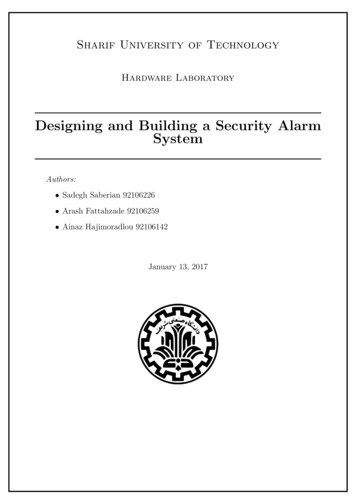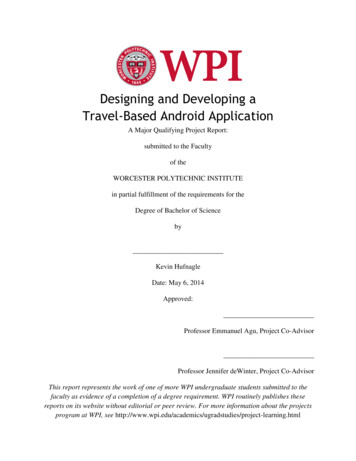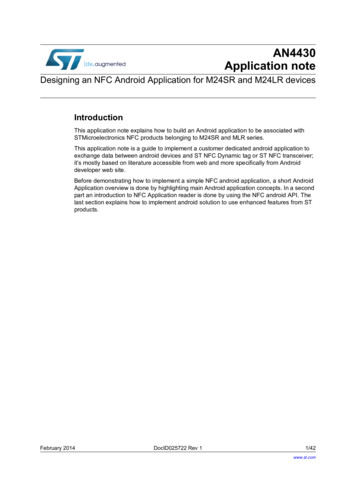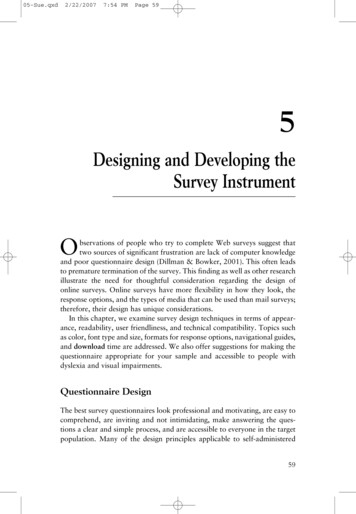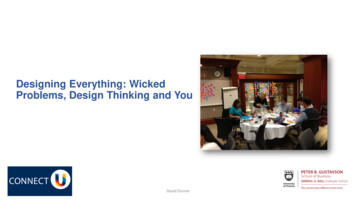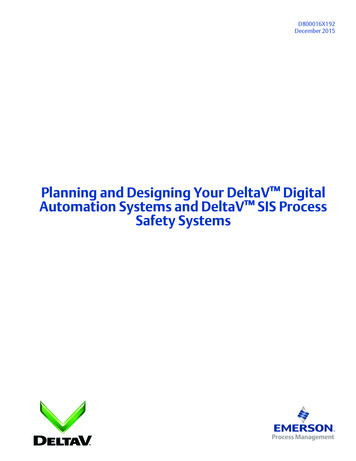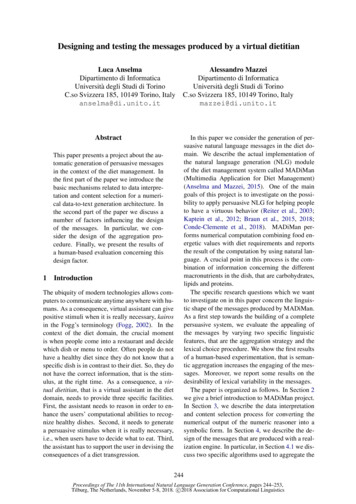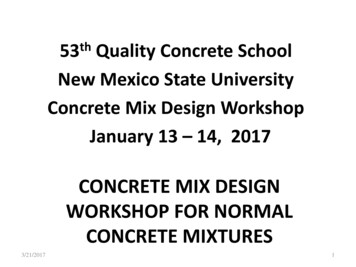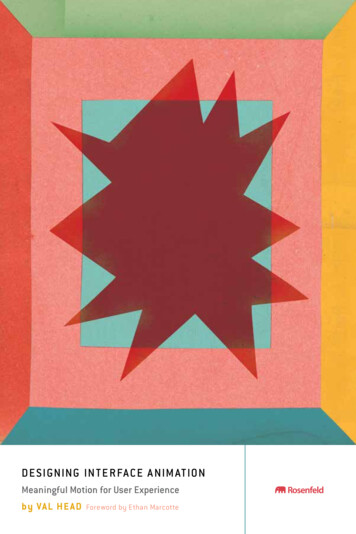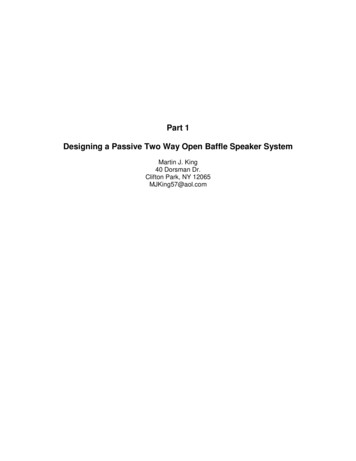
Transcription
Designing and Teaching an Intensively Hands–OnCourse in a Large Public UniversityLisa Abrams, Blaine Lilly, Dan Mendelsohn, Krishnaswamy SrinivasanDepartment of Mechanical and Aerospace EngineeringThe Ohio State University, Columbus, OH 43210Email: abrams.34@osu.eduAbstractIn Autumn 2012 the Ohio State University converted its academic calendar from a ten–week quarter system to a fifteen–week semester–based academic year. The Departmentof Mechanical and Aerospace Engineering (MAE) elected to take advantage of this veryrare opportunity to completely re–design the mechanical engineering curriculum.Following extensive discussions with alumni, students, industry, and faculty at Ohio Stateand other engineering institutions, the MAE department made the decision to add a newcourse for students entering the department in the second semester of their second year.The course was designed to emphasize hands–on skills while exposing students to typicalproblems that confront mechanical engineers in industry.This paper describes the evolution of the course as we first created a teaching platformthat would be at the heart of the course. Because the thrust of the course was to quicklyimmerse the students in hands–on engineering, we decided to build the entire coursearound the shop/laboratory experience. Lectures were structured to provide ‘just in time’information to the students as they fabricated, assembled, and tested the apparatus in thelaboratory. The design of this ‘teaching platform’ was clearly a crucial part of the entirecourse design.We pilot tested two versions of the course in 2011–2012, while still on the quartercalendar, and recently completed the first full semester version of the course. In thispaper we present the evolution of our design thinking, the problems encountered indesigning an appropriate ‘teaching platform’, and our experience in offering an intensivehands–on experience to almost two hundred students with widely differing levels ofexpertise.Introduction: redesigning the mechanical engineering curriculumIn August 2012 the Ohio State University converted from an academic calendar based onten–week quarters to one based on fifteen–week semesters. Three years previously, theDepartment of Mechanical and Aerospace Engineering (MAE) at Ohio State decided totake advantage of this academic conversion to re–design the entire mechanicalengineering curriculum. Following extensive discussions with industry, alumni, students,and faculty both at Ohio State and at several of our benchmark institutions, we elected toProceedings of the 2013 ASEE North-Central Section ConferenceCopyright 2013, American Society for Engineering Education
devote a larger percentage of the curriculum to experiential learning for ourundergraduates.Three major changes resulted from this decision: the required capstone course in the senior year was expanded to a two–semestersequence, with several different tracks made available to students with varyinginterests. These tracks ranged from conventional mechanical engineering problems tomotorsports, biomedical device design, product design, and an interdisciplinary designexperience through the College of Engineering. the manufacturing processes course that traditionally was taught in the second year wasmoved to the senior year and totally re–designed to better fit the specific needs ofmechanical engineers. The new course assumes a background in heat transfer andmachine design, and emphasizes experiential learning in the lab coupled with extensiveanalysis and simulation of manufacturing processes. an entirely new course, ME 2900 “Introduction to Design in Mechanical Engineering”is now required of all students entering the major, in the second semester of thesophomore year. This course is intended to provide students with skills they will needto successfully complete subsequent design courses in the major, and to make themeffective engineers more quickly when they begin their careers.This new course for sophomore–level students entering the major is the subject of thispaper. To date, we have piloted two ten–week versions of the course under the quartercalendar in 2011–2012, and have recently completed the first offering of the semester–long course to 198 students in December, 2012. We are currently teaching the second fullsemester course to another 160 second–year students. Our experience in preparing andteaching the course over the past two years has led to major changes in our expectationsfor the course, and in the structure of the course itself. This paper summarizes what wehave learned to date about creating a very intensive, hands–on experience for extremelylarge numbers of students.Background and motivationThe MAE Department at Ohio State, motivated by our own experience as well as reportsfrom ASME (specifically, its Vision 2030 study1), the National Science Foundation(NSF), the National Academy of Engineers (NAE), and benchmark universities, made thedecision to emphasize experiential learning while at the same time providing studentswith skills they’ll need to design and build engineered systems in later years. Villanova2University, Georgia Tech3, and Kettering University4 have recently documented newsophomore–level design courses focusing on providing a broad introduction tomechanical engineering and the fabrication of a device. The University of Houston5,Purdue University6, University of Southern Alabama7, Rensselaer Polytechnic Institute8,and Virginia Polytechnic Institute and State University9 also have sophomore levelcourses, but these courses focus more on the design and build process. Other schools suchProceedings of the 2013 ASEE North-Central Section ConferenceCopyright 2013, American Society for Engineering Education
as Pennsylvania State University10 and Rowan University11 are focusing onmultidisciplinary or multinational design teams. The University of Utah12 has alsoaddressed the challenge of large class size (a major constraint for our department) and hasrecently modified their curriculum to utilize more hands-on and active learning conceptswith 150 students per term.Beyond introducing mechanical engineering to entering students in an experientialcontext, an important secondary goal was to create a device – a ‘teaching platform’ – thatwould be able to integrate many facets of mechanical engineering. Like many otherundergraduate programs in mechanical engineering, our curriculum is divided into fourprimary areas: mechanics, machine design, thermal and fluid systems, and dynamicsystems and controls. In creating this new course, our intent was to show the studentshow these seemingly disparate parts of the curriculum mesh in practice. Thus the need tocreate a platform that was rich enough to support its integration in later courses over theremaining four semesters, yet broad enough to span the entire discipline.The compressed air motor is an ideal choice for several reasons. First, it allows us tointroduce thermodynamic concepts very early, and link them directly to energy, force,and torque. We quickly move to machine design and machine components, emphasize theimportance of precision, and show how precision is attained in the machine shop. Weexplicitly draw the connection between the datum surfaces in the CAD designs thestudents create, the datum surfaces on our machine tools, and how students must takethese factors into account in order to preserve design intent.The motor is also an ideal choice for introducing basic control concepts, such as openloop and closed–loop control. Students learn to program a small microprocessor, and useit to control the flow of air to their motor. Finally, testing the motor on a dynamometer atthe end of the semester allows us to give the students a very brief introduction to theproblems associated with data acquisition. The course syllabus is quite ambitious, but itachieves our goal of giving the students a broad introduction to our discipline.Course ConstraintsThe overriding goal of this course is to introduce second–year students to hands–on skillsthat they will need to be successful engineering designers, both in subsequent courses andmost especially, out on the job. This entails a need to provide extensive experience in themachine shop, the CAD studio, and the electronics laboratory. At Ohio State, given thelarge number of students who currently enroll in the major, our primary constraint in thedesign of this course was providing a truly rich experience for our students while alsocoping with burgeoning enrollments and shrinking resources.The undergraduate mechanical engineering program at the Ohio State University is oneof the largest in the country. Over the past seven years, the program has seen a significantincrease in enrollment, from 865 undergraduates in 2005 to 1337 in 2012. The program inmechanical engineering is now the largest undergraduate major in the College ofProceedings of the 2013 ASEE North-Central Section ConferenceCopyright 2013, American Society for Engineering Education
Engineering at Ohio State, and is one of the largest is the United States. In total, ourdepartment now serves almost 1800 pre–major, major, and graduate students inmechanical engineering, aeronautical engineering, and nuclear engineering programs.In planning a new course that relies so heavily on experiential learning, the primaryconstraint was simply finding a way to move large numbers of students through astructured set of exercises while maximizing the pedagogical benefit to the student.Autumn 2011: the first pilot courseIn early Spring, 2011, the decision was made to offer two pilot versions of the new courseduring the 2011–2012 academic year. Given that our academic quarters were only tenweeks long, it was not possible to pilot an entire semester–length course in a singlequarter without greatly increasing the number of hours students would spend in class. Ouroriginal solution was to offer two distinct pilot courses: the first, offered in Autumn 2011,would emphasize the machine shop aspects of the course; the second, following in Winter2012, would require less time in the machine shop, but much more time working in theelectronics lab with the Arduino microprocessor.In Autumn Quarter, 2011, we launched the first pilot course with a group of second andthird–year students, all of whom volunteered to take the class as a technical elective. Inthe spring of 2011 we visited several second–year mechanical engineering classes to alertstudents that these pilots would be offered in the 2011–2012 academic year. We followedthat up with an evening recruitment event in late spring, and succeeded in recruiting 26second–year students for the first pilot. Of the 26 students, five were female and one wasHispanic. Sixteen students had completed the first year honors engineering programbefore entering the department, nine went through the standard first year engineeringprogram, and one student transferred from another university.From the beginning, our intent was that the course would be built around a fairly complexdevice that the students would construct and test. Students would attend two 1.5 hourlectures per week, in addition to a two–hour lab period, which would be spent in eitherthe machine shop or the electronics lab. Lectures would be structured to provide neededinformation ‘just in time’ for students to apply it in the shop or lab. Our belief was, andcontinues to be, that by immediately applying lecture material, students will internalizeand retain material more effectively.Our first task was to decide on a suitable teaching platform, i.e, the mechanical devicethat the students would construct and test. Because of the centrality of this device to thecourse, this decision was not an easy one. Clearly, the device had to be simple enough tobe constructed by second–year students with very limited hands–on skills. At the sametime, it needed to be complex enough to satisfy our requirements. In summary, the deviceneeded to: Challenge students to develop real proficiency in using the machine shop andelectronics lab;Offer interesting control scenarios, the better to integrate with the microprocessor;Proceedings of the 2013 ASEE North-Central Section ConferenceCopyright 2013, American Society for Engineering Education
Provide a rich enough experience to cover a wide range of mechanicalengineering problems;Integrate well with subsequent courses in the curriculum.After much discussion, and based on our review of the literature, we elected to have thestudents work in teams to fabricate a fairly complex inline two–cylinder compressed airmotor, shown in Figure 1. The idea for using a compressed air motor as the ‘teachingplatform’ came from similar projects at the US Coast Guard Academy and at CornellUniversity. While researching several air motor designs, we discovered that a group ofstudents in our own program had designed and built a two–cylinder version of a motorfor their capstone project during the previous year. This motor became the basis of ournew design.Figure 1: The first iteration of the air motor design. This two–cylinder motor requires a dual–lobe cam andfollowers to control air flow, and has over thirty separate components; most of which are machined by thestudents.During summer 2011, a M.S. student in our program, working closely with the machineshop supervisor, re–designed the original motor to create a more robust design that wasProceedings of the 2013 ASEE North-Central Section ConferenceCopyright 2013, American Society for Engineering Education
also more challenging to fabricate. This motor became the prototype for the first pilotclass13. The motor was assembled from over thirty separate components, most of whichwere machined on lathes and milling machines by the students. The tolerances requiredfor robust performance were considerable, but the students were able to machine partsfrom aluminum, bronze, and steel to the required tolerance levels
University, Georgia Tech3, and Kettering University4 have recently documented new sophomore–level design courses focusing on providing a broad introduction to mechanical engineering and the fabrication of a device. The University of Houston5, Purdue University6, University of Southern Alabama7, Rensselaer Polytechnic Institute8,
